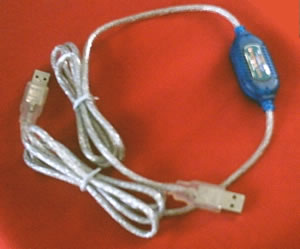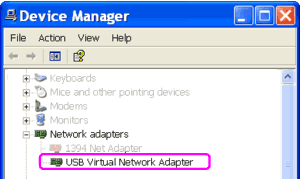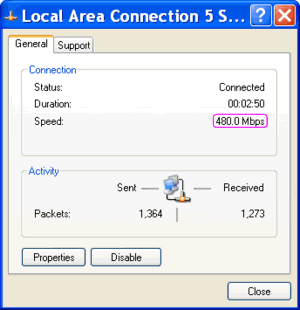USB Direct Connection
Question
Since USB port is on every PC, is it possible to connect two PCs via USB ports using a USB cable?
Answer
Full Speed USB (USB 1.1) and
High Speed USB (USB 2.0) specifications do not specify the use of a simple USB A-to-A
cable for connecting two USB hosts. USB was designed to connect up
to 127 USB peripherals to a USB host
(typically a PC). It was not designed as a LAN
technology and the USB Implementers Forum recommends existing LAN
technology such as Ethernet for creating a computer network.
But maybe because users were interested in connecting computers
using USB cable, many vendors worked out this "limitation" of USB
specifications by making a special hardware, that's USB bridge or
sometimes known as USB-to-USB adapter. A USB bridge emulates an NDIS-compliant LAN adapter. You can easily find an A-to-A USB cable with a USB bridge
on the cable at computer or networking stores.

Figure: A USB bridge cable for USB networking.
The cable length is usually 2 meters and newer products support USB
2.0, so theoretically the USB bridge can transfer data at up to 480
Mbps, faster than the ubiquitous Fast Ethernet or even the pre-N Wi-Fi. Several
vendors
make USB bridge cable which can work in two modes, that's for simple data
transfer between two computers and local area networking (LAN). If you
want to copy or move large files from one computer to another, choose the
direct transfer mode. If you want to network computers for file and printer sharing
or Internet connection sharing, choose the virtual LAN mode.
To connect two computers (PCs) using a USB bridge in Windows XP:
- Install the software that comes with your hardware. It will copy the driver
to your computer.
- Plug the USB bridge cable end to your computer' USB port.
- Follow the instructions on the Found New Hardware Wizard that appears to
install the USB network adapter.
- Verify that the USB network adapter has been installed from the Device
Manager.

- A Local Area Connection will be created under LAN or High Speed Internet
in Network Connections folder. You can use the Network Setup Wizard or
define IP address and configure other settings manually via the Network Connections folder.
The
step-by-step instructions are similar with direct connection using Ethernet
crossover cable. It includes defining
computer and workgroup names, assigning private IP addresses and preparing
files/folders, printer or Internet connection for sharing.
- If you find troubles when configuring the connection using Windows automatic
private IP address assignment (DHCP), define a static IP address for each USB network
adapter on each computer. Both IP addresses must be within the same subnet.
- If both PCs have USB 2.0 ports, you are going to have a 480 Mbps
connection. If one PC has USB 1.1 port, the connection speed will fall to 12
Mbps.

Note:
1. A-to-A USB cable has a type A USB connector at both ends. An A-connector is
the rectangular connector that is plugged into a computer (USB host) or USB
hub.
2. A USB bridge cable can also be used to connect a computer to a USB hub to
create a LAN with more than two computers.
3. NDIS: Network Driver Interface Specification.
|